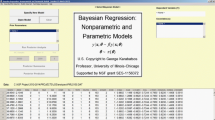Abstract
Equally weighted mixture models are recommended for situations where it is required to draw precise finite sample inferences requiring population parameters, but where the population distribution is not constrained to belong to a simple parametric family. They lead to an alternative procedure to the Laird-DerSimonian maximum likelihood algorithm for unequally weighted mixture models. Their primary purpose lies in the facilitation of exact Bayesian computations via importance sampling. Under very general sampling and prior specifications, exact Bayesian computations can be based upon an application of importance sampling, referred to as Permutable Bayesian Marginalization (PBM). An importance function based upon a truncated multivariatet-distribution is proposed, which refers to a generalization of the maximum likelihood procedure. The estimation of discrete distributions, by binomial mixtures, and inference for survivor distributions, via mixtures of exponential or Weibull distributions, are considered. Equally weighted mixture models are also shown to lead to an alternative Gibbs sampling methodology to the Lavine-West approach.
Similar content being viewed by others
References
Alspach, D. L. (1975). A Gaussian sum approach to the multi-target identification tracking problem,Automatica,11, 285–296.
Ansfield, F., Klotz, J., Nealton, T., Ramirez, G., Minton, J., Hill, G., Wilson, W., Davis, H. and Cornell, G. (1977). A phase III study comparing the clinical utility of four regimens of 5-Fluorouracil,Cancer,39, 34–38.
Bates, D. M. and Watts, D. G. (1988).Non-Linear Regression Analysis and Its Applications, Wiley, New York.
Burridge, J. (1981). Empirical Bayes analysis of survival time data,J. Roy. Statist. Soc. Ser. B,43, 65–75.
Carlin, B. P. and Gelfand, A. E. (1990). Approaches for empirical Bayes confidence intervals,J. Amer. Statist. Assoc.,85, 105–114.
Cox, D. R. and Oakes, D. (1985).The Analysis of Survival Data, Chapman and Hall, New York.
DerSimonian, R. (1986). Maximum likelihood estimation of a mixing distribution algorithm,Appl. Statist.,35, 302–309.
Efron, B. (1967). The two sample problem with censored data,Proc. Fifth Berkeley Symp. on Math. Statist. Prob., Vol. IV, 831–853, Univ. of California Press, Berkeley.
Gelfand, A. E. and Smith, A. F. M. (1990). Sampling based approaches to calculating marginal densities,J. Amer. Statist. Assoc.,85, 393–397.
Geweke, J. (1988). Antithetic acceleration of Monte-Carlo integration in Bayesian inference,J. Econometrics,38, 73–89.
Geweke, J. (1989). Exact predictive densities for linear models with arch distribution,J. Econometrics,40, 63–86.
Hsu, J. S. J. (1990). Bayesian inference and marginalization, Ph.D. Thesis, University of Wisconsin-Madison.
Hsu, J. S. J., Leonard, T. and Tsui, K. (1991). Statistical inference for multiple choice tests,Psychometrika,56, 327–348.
Kalbfleisch, T. D. and Prentice, R. L. (1980).The Statistical Analysis of Failure Time Data, Wiley, New York.
Kaplan, E. L. and Meier, P. (1958). Nonparametric estimation from incomplete observations,J. Amer. Statist. Assoc.,53, 457–487.
Laird, N. M. (1978). Non-parametric maximum likelihood estimation of a mixing distribution,J. Amer. Statist. Assoc.,73, 361–379.
Laird, N. M. (1982). Empirical Bayes estimation using the non-parametric maximum likelihood estimate of the prior,J. Statist. Comput. Simulation,15, 211–220.
Lavine, M. and West, M. (1992). A Bayesian method for classification and discrimination,Canad. J. Statist.,20, 451–461.
Lenk, P. (1991). Toward a practicable Bayesian non-parametric density estimator,Biometrika,78, 531–544.
Leonard, T. (1972). Bayesian methods for binomial data,Biometrika,59, 581–589.
Leonard, T. (1978). Density estimation, stochastic processes and prior information (with Discussion),J. Roy. Statist. Soc. Ser. B,40, 113–146.
Leonard, T. (1984). Some data-analytic modifications to Bayes-Stein estimation,Ann. Inst. Statist. Math.,36, 11–21.
Leonard, T. and Hsu, J. S. J. (1992). Bayesian inference for a covariance matrix,Ann. Statist.,20, 1669–1696.
Leonard, T., Hsu, J. S. J. and Tsui, K. (1989). Bayesian marginal inference,J. Amer. Statist. Assoc.,84, 1051–1057.
Lindsay, B. G. (1981). Properties of the maximum likelihood estimator of a mixing distribution,Statistical Distribution in Scientific Work (eds. C. Taillie, G. Patial and B. Baldessari),5, 95–109, Reidel, Holland.
Lindsay, B. G. (1983). A geometry of mixture likelihoods Part II: The exponential family,J. Amer. Statist. Assoc.,4, 1200–1209.
Mallet, A. (1986). A maximum likelihood estimation method for random coefficient models,Biometrika,73, 645–656.
Ogata, Y. (1989). A Monte Carlo method for high-dimensional integration,Numer. Math.,55, 137–157.
Ogata, Y. (1990). A Monte Carlo method for an objective Bayesian procedure,Ann. Inst. Statist. Math.,42, 403–433.
Rosenblatt, M. (1956). Remarks on some nonparametric estimates of a density function,Ann. Math. Statist.,27, 832–835.
Rubinstein, R. Y. (1981).Simulation and the Monte-Carlo Method, Wiley, New York.
Simar, L. (1978). Maximum likelihood estimation of a compound Poisson process,Ann. Statist.,4, 1206–1209.
Sorenson, H. W. and Alspach, D. L. (1971). Recursive Bayesian estimation using Gaussian sums,Automatica,7, 465–479.
Sweeting, T. J. (1987). Approximate Bayesian analysis for censored survival data,Biometrika,74, 809–816.
Tanner, T. A. and Wong, W. H. (1987). The calculation of posterior distributions by data augmentation,J. Amer. Statist. Assoc.,81, 82–86.
Tapia, R. A. and Thompson, J. R. (1978).Nonparametric Probability Density Estimation, John Hopkins University Press, Baltimore.
Tierney, L. and Kadane, J. (1986). Accurate approximations for posterior moments and marginal densities,J. Amer. Statist. Assoc.,82, 528–549.
Titterington, D. M., Smith, A. F. M. and Makov, U. E. (1985).Statistical Analysis of Finite Mixture Distributions, Wiley, New York.
Author information
Authors and Affiliations
About this article
Cite this article
Leonard, T., Hsu, J.S.J., Tsui, KW. et al. Bayesian and likelihood inference from equally weighted mixtures. Ann Inst Stat Math 46, 203–220 (1994). https://doi.org/10.1007/BF01720581
Received:
Revised:
Issue Date:
DOI: https://doi.org/10.1007/BF01720581



